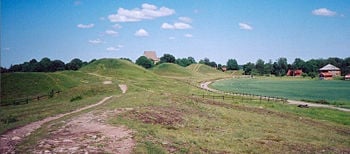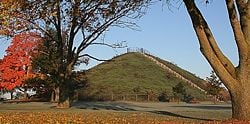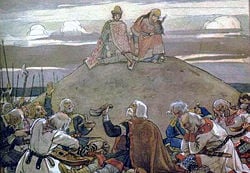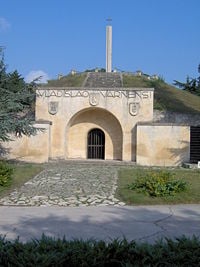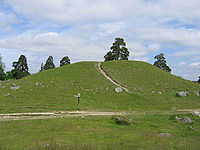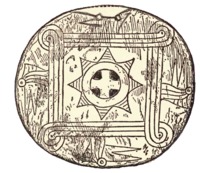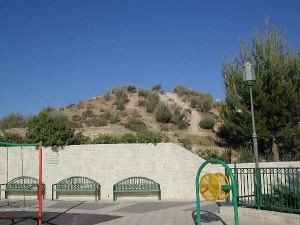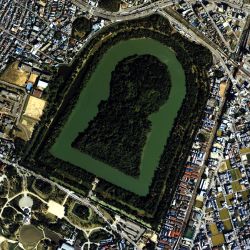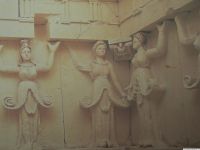Difference between revisions of "Tumulus" - New World Encyclopedia
Nick Perez (talk | contribs) |
Nick Perez (talk | contribs) |
||
| Line 13: | Line 13: | ||
==Archaeology== | ==Archaeology== | ||
| − | [[Image:miamisburg_jqj.jpg|thumb|left|Miamisburg Mound, the largest conical mound in Ohio, is attributed to the [[Adena Culture|Adena archaeological culture]].]] | + | [[Image:miamisburg_jqj.jpg|thumb|left|250px|Miamisburg Mound, the largest conical mound in Ohio, is attributed to the [[Adena Culture|Adena archaeological culture]].]] |
Although people were aware of the existence of burial mounds for many years, they remained mysterious until the 19th century, when amateur [[Archaeology|archaeologists began using scientific techniques in regards to excavations. The first mounds excavated were in [[Peru]], at the site of the [[Huaca de Tantalluc]], but [[Thomas Jefferson]], before he became the third [[President of the United States]], was the first to receive widespread recognition for excavating tumuli. | Although people were aware of the existence of burial mounds for many years, they remained mysterious until the 19th century, when amateur [[Archaeology|archaeologists began using scientific techniques in regards to excavations. The first mounds excavated were in [[Peru]], at the site of the [[Huaca de Tantalluc]], but [[Thomas Jefferson]], before he became the third [[President of the United States]], was the first to receive widespread recognition for excavating tumuli. | ||
By noting the [[stratigraphy]] of the soil and rock on a cross-section of the burial mound he excavated in the [[Mississippi Valley]], and the relative age difference between the skeletons found in the lower sections compared to those remains closer to the surface, Jefferson was able to deduce that the mound had been revisited several times over the course of years, each time a new layer of sediment and human remains being added. While this did not end the debate over who had created the mounds (see '''The Moundbuilder Myth''' below), it did consititute a breakthrough in how archaeology could be used to examine the phenomena.<ref>(2000) Renfrew, Colin and Paul Bahn "Archaeology: Theories, Methods and Practice" (3rd Edition) Thames and Hudson. ISBN 0500281475 </ref> | By noting the [[stratigraphy]] of the soil and rock on a cross-section of the burial mound he excavated in the [[Mississippi Valley]], and the relative age difference between the skeletons found in the lower sections compared to those remains closer to the surface, Jefferson was able to deduce that the mound had been revisited several times over the course of years, each time a new layer of sediment and human remains being added. While this did not end the debate over who had created the mounds (see '''The Moundbuilder Myth''' below), it did consititute a breakthrough in how archaeology could be used to examine the phenomena.<ref>(2000) Renfrew, Colin and Paul Bahn "Archaeology: Theories, Methods and Practice" (3rd Edition) Thames and Hudson. ISBN 0500281475 </ref> | ||
| Line 21: | Line 21: | ||
==Theories== | ==Theories== | ||
| + | [[Image:Trizna 1899.jpg|thumb|right|250px|Burial of [[Oleg of Novgorod]] in a tumulus in 912. Painting by [[Viktor Vasnetsov]].]] | ||
The process of creating tumuli is one that has fascinated archaeologists for some time, if for no other reason than that it is one of the few human activities that appear to be universal and not cultural diffused. The question of how and why burial mounds came to be common practice is one open to debate. The act of human burial has long been viewed as an outgrowth of proto-religious belief; how the body is cared for after someone has died affects that person in the afterlife. Burial mounds appear to be no different. Some have argued that tumuli started as burial sites for people of importance and significance, the visible mounds paying tribute to these persons of importance, much the same way that the pyramids were both tombs and tributes to the Pharaohs. Others have argued against this claim, and believe that burial mounds for structured mass graves for all people, while still others have claimed that burial mounds were completely random phenomenons with no cognitive though going into their creation and construction.<ref>(1996)Glenn Black Laboratory of Archaeology and The Trustees of Indiana University [[http://www.gbl.indiana.edu/abstracts/adena/mounds.html"Burial Mounds"]] Retrieved August 20, 2007</ref> It may never be known why exactly tumuli were created, but from the studies done so far, it is clear that each tumuli reveals something about the culture it was created in, the beliefs and practices of the people and their concern for the dead. | The process of creating tumuli is one that has fascinated archaeologists for some time, if for no other reason than that it is one of the few human activities that appear to be universal and not cultural diffused. The question of how and why burial mounds came to be common practice is one open to debate. The act of human burial has long been viewed as an outgrowth of proto-religious belief; how the body is cared for after someone has died affects that person in the afterlife. Burial mounds appear to be no different. Some have argued that tumuli started as burial sites for people of importance and significance, the visible mounds paying tribute to these persons of importance, much the same way that the pyramids were both tombs and tributes to the Pharaohs. Others have argued against this claim, and believe that burial mounds for structured mass graves for all people, while still others have claimed that burial mounds were completely random phenomenons with no cognitive though going into their creation and construction.<ref>(1996)Glenn Black Laboratory of Archaeology and The Trustees of Indiana University [[http://www.gbl.indiana.edu/abstracts/adena/mounds.html"Burial Mounds"]] Retrieved August 20, 2007</ref> It may never be known why exactly tumuli were created, but from the studies done so far, it is clear that each tumuli reveals something about the culture it was created in, the beliefs and practices of the people and their concern for the dead. | ||
| Line 39: | Line 40: | ||
===Bulgaria=== | ===Bulgaria=== | ||
| − | [[Image:VarnaMemorial.jpg| | + | [[Image:VarnaMemorial.jpg|right|thumb|200px|Memorial of the [[Battle of Varna]] of 1444 carved into an ancient [[Thracians|Thracian]] burial mound. The sign in front is for [[Władysław III of Poland]]]] |
Hundreds of [[Thracian]] burial mounds are found throughout Bulgaria, including the [[Thracian Tomb of Kazanlak|Kazanlak]] and [[Thracian Tomb of Sveshtari|Sveshtari]] tombs, [[UNESCO]] [[World Heritage]] sites. Located near the ancient Thracian capital cities of [[Seuthopolis]] (of the [[Odrysian kingdom]]) and Daosdava or Helis (of the [[Getae]]), perhaps they represented royal burials. Other tombs contained offerings such as the [[Panagyuriste treasure|Panagyurishte]] and [[Rogozen treasure|Rogozen]] treasures. | Hundreds of [[Thracian]] burial mounds are found throughout Bulgaria, including the [[Thracian Tomb of Kazanlak|Kazanlak]] and [[Thracian Tomb of Sveshtari|Sveshtari]] tombs, [[UNESCO]] [[World Heritage]] sites. Located near the ancient Thracian capital cities of [[Seuthopolis]] (of the [[Odrysian kingdom]]) and Daosdava or Helis (of the [[Getae]]), perhaps they represented royal burials. Other tombs contained offerings such as the [[Panagyuriste treasure|Panagyurishte]] and [[Rogozen treasure|Rogozen]] treasures. | ||
| Line 53: | Line 54: | ||
Some of the world's most prominent Tumuli, the Macedonian tombs and a cist-grave at [[Vergina]], tomb of [[Philip II of Macedon|Philip II]] (359-336 B.C.E.) of Macedonia and father of [[Alexander the Great]] (336-323). Speculation that the other grave found there is that of [[Alexander IV]] is controversial. His corpse was allegedly buried in Memphis during the turmoil of the Diadochi after his death in 323 B.C.E.<ref> (2007) Lendering, Jona. [[http://www.livius.org/aj-al/alexander01/alexander_iv.html"Alexander VI"]] Retrieved August 20, 2007 </ref> | Some of the world's most prominent Tumuli, the Macedonian tombs and a cist-grave at [[Vergina]], tomb of [[Philip II of Macedon|Philip II]] (359-336 B.C.E.) of Macedonia and father of [[Alexander the Great]] (336-323). Speculation that the other grave found there is that of [[Alexander IV]] is controversial. His corpse was allegedly buried in Memphis during the turmoil of the Diadochi after his death in 323 B.C.E.<ref> (2007) Lendering, Jona. [[http://www.livius.org/aj-al/alexander01/alexander_iv.html"Alexander VI"]] Retrieved August 20, 2007 </ref> | ||
| − | |||
Excavations were first undertaken at this site by 19th century. Archaeologists [[L. Heuzy]] of France and [[K. Rhomaios]] of Greece began but were stalled by the [[World War I|First]] and [[World War II|Second]] World Wars. In the 1960s [[M. Andronicos]] was director of the excavations and the cemetery of the tumuli was investigated. The Palace of Philip II was excavated by a team from [[Thessaloniki University]] along with part of the necropolis being investigated by the Ministry of Culture. 1977 was the pivotal date that M. Andronicos brought to the attention of the world, the royal tombs in the Great Tumulus of Vergina, (ΜεγάΛα) tomb. Unfortunately, the townspeople of Vergina have put a halt to any more excavations for the time being, under the auspices of preserving their beautiful surroundings and heritage.<ref> (2007) The Museum of Macedonia [[http://www.macedonian-heritage.gr/Museums/Archaeological_and_Byzantine/Arx_Bas_Tafoi_Berginas.html"Royal Tombs—Vergina"]] Retrieved August 20, 2007</ref> | Excavations were first undertaken at this site by 19th century. Archaeologists [[L. Heuzy]] of France and [[K. Rhomaios]] of Greece began but were stalled by the [[World War I|First]] and [[World War II|Second]] World Wars. In the 1960s [[M. Andronicos]] was director of the excavations and the cemetery of the tumuli was investigated. The Palace of Philip II was excavated by a team from [[Thessaloniki University]] along with part of the necropolis being investigated by the Ministry of Culture. 1977 was the pivotal date that M. Andronicos brought to the attention of the world, the royal tombs in the Great Tumulus of Vergina, (ΜεγάΛα) tomb. Unfortunately, the townspeople of Vergina have put a halt to any more excavations for the time being, under the auspices of preserving their beautiful surroundings and heritage.<ref> (2007) The Museum of Macedonia [[http://www.macedonian-heritage.gr/Museums/Archaeological_and_Byzantine/Arx_Bas_Tafoi_Berginas.html"Royal Tombs—Vergina"]] Retrieved August 20, 2007</ref> | ||
| Line 59: | Line 59: | ||
In [[United Kingdom|Britain]], early references to tumuli were made by [[William Camden]], [[John Aubrey]], and [[William Stukeley]]. During the 19th century in [[England]] the excavation of tumuli was a popular [[pastime]] amongst the educated and wealthy middle classes, who became known as "barrow-diggers." This leisure activity played a key role in laying the foundations for the scientific study of the past in Britain but also resulted in untold damage to the sites. Barrows were popularly used to bury the dead from the late [[Neolithic]] until the end of the [[Bronze Age]], 2900-800B.C.E. [[Square barrows]] were occasionally used in the Iron Age (800B.C.E.-43C.E.) in the east of England. The traditional round barrow experienced a brief resurgence after the [[Anglo-Saxons|Anglo-Saxon]] invasion ,as Scandinavian burial practice became popular 500-600C.E. These later barrows were often built near older Bronze Age barrows. | In [[United Kingdom|Britain]], early references to tumuli were made by [[William Camden]], [[John Aubrey]], and [[William Stukeley]]. During the 19th century in [[England]] the excavation of tumuli was a popular [[pastime]] amongst the educated and wealthy middle classes, who became known as "barrow-diggers." This leisure activity played a key role in laying the foundations for the scientific study of the past in Britain but also resulted in untold damage to the sites. Barrows were popularly used to bury the dead from the late [[Neolithic]] until the end of the [[Bronze Age]], 2900-800B.C.E. [[Square barrows]] were occasionally used in the Iron Age (800B.C.E.-43C.E.) in the east of England. The traditional round barrow experienced a brief resurgence after the [[Anglo-Saxons|Anglo-Saxon]] invasion ,as Scandinavian burial practice became popular 500-600C.E. These later barrows were often built near older Bronze Age barrows. | ||
| + | [[Image:Hågahögen.jpg|thumb|rightt|200px|King Björn's barrow in Håga.]] | ||
===Scandinavia=== | ===Scandinavia=== | ||
| − | [[Image:180px-Ottar03.jpg|thumb|200px|''[[Ohthere]]'s mound'' in [[Vendel]], [[Sweden]] from the early 6th century.]] | + | [[Image:180px-Ottar03.jpg|thumb|left|200px|''[[Ohthere]]'s mound'' in [[Vendel]], [[Sweden]] from the early 6th century.]] |
Burial mounds were in use until the 11th century in Scandinavia. In their undamaged state they appear as small, man-made hillocks, though many examples have been damaged by [[ploughing]] or deliberately damaged so that little visible evidence remains. | Burial mounds were in use until the 11th century in Scandinavia. In their undamaged state they appear as small, man-made hillocks, though many examples have been damaged by [[ploughing]] or deliberately damaged so that little visible evidence remains. | ||
| − | By burning the deceased, it was believed that the person was transferred to [[Valhalla]] by the consuming force of the fire. The fire could reach temperatures of 1500 °C. The remains were covered with cobblestones and then a layer of gravel and sand and finally a thin layer of turf. | + | By burning the deceased, it was believed that the person was transferred to [[Valhalla]] by the consuming force of the fire. The fire could reach temperatures of 1500 °C. The remains were covered with cobblestones and then a layer of gravel and sand and finally a thin layer of turf. As the old Scandinavians worshiped their ancestors, the mounds were alo places of worship. Of note is King Björn's barrow in Håga ([[Old Norse]] name: ''Haug'') near [[Uppsala]]. This location has a very strong connection with [[Björn at Haugi]]. First, the [[Nordic Bronze Age]] barrow gave its name to the location ''Håga'' ("the barrow"), which became part of the cognomen of the king, ''at Haugi'' ("at the barrow"), and interestingly, the mound was later named after the king. |
| − | |||
| − | As the old Scandinavians worshiped their ancestors, the mounds were | ||
In [[Norse mythology]], the [[draugr]] was an undead creature that haunted burial mounds. | In [[Norse mythology]], the [[draugr]] was an undead creature that haunted burial mounds. | ||
| Line 72: | Line 71: | ||
===Canada=== | ===Canada=== | ||
| − | [[Image:Mound001.jpg|200px| | + | [[Image:Mound001.jpg|200px|left|thumb|The 7,500-year-old, rock-covered burial mound of a Maritime Archaic boy at L'Anse Amour, Newfoundland and Labrador.]]Human settlement in [[L'Anse Amour, Newfoundland and Labrador|L'anse Amour]] dates back at least 7,500 years as evidenced by the burial mound of a Maritime Archaic boy here. His body was wrapped in a shroud of bark or hide and placed face down with his head pointed to the west. The site was first excavated in the 1970s. |
The Augustine Mound is an important [[Mi'kmaq]] burial site in New Brunswick. | The Augustine Mound is an important [[Mi'kmaq]] burial site in New Brunswick. | ||
===United States=== | ===United States=== | ||
| − | + | [[Image:Serpent mound 8438.jpg|thumb|200px|[[Serpent Mound]] – an ancient [[Native Americans in the United States|Native American]] ceremonial structure in Ohio.]] | |
Mound building was a central feature of the public [[architecture]] of many [[Indigenous peoples of the Americas|Native American]] cultures from Chile to Minnesota. Thousands of mounds in the USA have been destroyed as a result of farming, pot-hunting, amateur and professional archaeology, road-building and construction. Surviving mounds are still found in river valleys, especially along the [[Mississippi River|Mississippi]], [[Tennessee River|Tennessee]] and [[Ohio River|Ohio]] Rivers. | Mound building was a central feature of the public [[architecture]] of many [[Indigenous peoples of the Americas|Native American]] cultures from Chile to Minnesota. Thousands of mounds in the USA have been destroyed as a result of farming, pot-hunting, amateur and professional archaeology, road-building and construction. Surviving mounds are still found in river valleys, especially along the [[Mississippi River|Mississippi]], [[Tennessee River|Tennessee]] and [[Ohio River|Ohio]] Rivers. | ||
[[Effigy mound]]s were used for burial, to support residential and religious structures, to represent a shared [[cosmology]], and to unite and demarcate community. Common forms include conical mounds, ridge-top mounds, [[platform mound]]s, and animal [[effigy]] mounds, but there are many variations. Mound building in the USA is believed to date back to at least 1200 B.C.E. in the Southeast (see [[Poverty Point]]), and recent research shows that it may predate that as well. The [[Adena culture|Adena]] and [[Mississippian culture|Mississippian]] cultures are principally known for their mounds. The largest mound site north of [[Mexico]] is [[Cahokia]], a vast [[World Heritage Site]] located just east of St. Louis, Missouri. The most visually impressive mound site (due to the area being free of trees) is in [[Moundville, Alabama]]. The largest conical burial mound can be found in [[Moundsville, West Virginia]]. | [[Effigy mound]]s were used for burial, to support residential and religious structures, to represent a shared [[cosmology]], and to unite and demarcate community. Common forms include conical mounds, ridge-top mounds, [[platform mound]]s, and animal [[effigy]] mounds, but there are many variations. Mound building in the USA is believed to date back to at least 1200 B.C.E. in the Southeast (see [[Poverty Point]]), and recent research shows that it may predate that as well. The [[Adena culture|Adena]] and [[Mississippian culture|Mississippian]] cultures are principally known for their mounds. The largest mound site north of [[Mexico]] is [[Cahokia]], a vast [[World Heritage Site]] located just east of St. Louis, Missouri. The most visually impressive mound site (due to the area being free of trees) is in [[Moundville, Alabama]]. The largest conical burial mound can be found in [[Moundsville, West Virginia]]. | ||
| − | [[Image: | + | Other sites in the U.S.A. include [[Indian Mounds Park, Wisconsin]], [[Indian Mounds Park (Saint Paul, Minnesota)]], and [[Indian Mound Park, Alabama]]. |
| + | [[Image:AncientCherokeeGorget.png|thumb|left|200px|Many engraved [[conch shell]] artifacts, such as this one from a mound in Tennessee, have been found.]] | ||
| + | Through the mid-1800s, Native Americans were generally not believed to have built the mounds of the eastern U.S. A key work in the widespread recognition of the true origins of the mounds was the lengthy 1894 report of [[Cyrus Thomas]] of the [[Bureau of American Ethnology]], which concluded that the prehistoric earthworks of the eastern United States were the work of Native Americans. Today, the term '''Mound Builder''' is a general term referring to the [[Indigenous peoples of North America|Native North American peoples]] who constructed various styles of earthen [[mound]]s for burial, residential, and ceremonial purposes. These included [[Archaic period|Archaic]], and [[Woodland period]], and [[Mississippian culture|Mississippian period]] [[Pre-Columbian]] cultures dating from roughly 3000 B.C.E. to the 1500s, and living in the [[Great Lakes]] region, the [[Ohio River]] region, and the [[Mississippi River]] region. | ||
| + | |||
| − | |||
| − | [[Image: | + | ==Middle East== |
| + | |||
| + | ===Israel=== | ||
| + | [[Image:JerusalemTumulus2.jpg|thumb|300px|right|Jerusalem Tumulus #2 in 2004.]] Near the western city limits of modern [[Jerusalem]] in [[Israel]], 19 tumuli have been documented (Amiran, 1958). Though first noticed in the 1870s by early surveyors, the first one to be formally documented was Tumulus #2 in 1923 by [[William Foxwell Albright]], and the most recent one (Tumulus #4) was excavated by [[Gabriel Barkay]] in 1983. Since 21 kings reigned in Jerusalem during the [[Israelite]] monarchy from [[David]] to [[Zedekiah]] (who was conquered and humiliated by the [[Chaldea]]n king, [[Nebuchadnezzar II of Babylon|Nebuchadnezzar]]), it is not unreasonable to suspect that these mounds were the locations of ceremonies to mourn/honor them after they had already received proper burial in the royal tombs (probably located in the heart of the city where they could be continuously guarded). See [[2 Chronicles]] 16:14, 21:19 (which states that King [[Jehoram of Judah|Jehoram]] was not given this honor), 32:33, the [[book of Jeremiah]] 34:5 (a conditional promise for Zedekiah that he did not earn), and [[Biblical archaeology]]. Gabriel Barkay popularized this theory after studying tumuli near Salamis in [[Cyprus]]. | ||
| − | |||
===Turkey=== | ===Turkey=== | ||
On the [[Anatolian]] peninsula, there are several sites where one can find the biggest specimens of these artificial mounds throughout the world. Three of these sites are especially important. Bin Tepeler (and other [[Lydian]] mounds of the Aegean inland), [[Phrygia|Phrygian]] mounds in [[Gordium]] (Central Anatolia) and the famous [[Commagene]] tumulus on the Mount [[Nemrut (mountain)|Nemrut]] (Southeastern Anatolia). | On the [[Anatolian]] peninsula, there are several sites where one can find the biggest specimens of these artificial mounds throughout the world. Three of these sites are especially important. Bin Tepeler (and other [[Lydian]] mounds of the Aegean inland), [[Phrygia|Phrygian]] mounds in [[Gordium]] (Central Anatolia) and the famous [[Commagene]] tumulus on the Mount [[Nemrut (mountain)|Nemrut]] (Southeastern Anatolia). | ||
| − | + | Bin Tepeler is the most important of the enumerated sites with the number of specimens it has and with the dimensions of certain among them. It is in the [[Aegean Sea|Aegean]] inland of Turkey. The site is called "Bin Tepeler" (a thousand mounds in Turkish) and it is in the northwest of [[Salihli]] district of [[Manisa Province|Manisa]] province. The site is very close to the southern shoreline of [[Lake Marmara]] (Lake Gyges or Gygaea). Bin Tepeler is a [[Lydian]] [[necropolis]] which dates back to 7th and 6th centuries B.C.E. These mounds are called "the pyramids of Anatolia" as there is even a giant specimen among them which attains 355 meters in diameter, 1115 meters in perimeter and 69 meters of height. According to the accounts drawn up by [[Herodotus]], this giant tumulus belongs to the famous Lydian King [[Alyattes II]] who ruled between 619-560 B.C.E. There is also another mound belonging to King [[Gyges of Lydia|Gyges]]. The Gyges mound was excavated but the burial chamber hasn't been found yet. In this site, there are 75 tumuli dating back to Lydian period which belong to the nobility. A large number of smaller artificial mounds can also be observed in the site. There are other Lydian tumuli sites around [[Eşme]] district of [[Uşak Province|Uşak]] province. Certain mounds in these sites had been plundered by raiders in the late 1960s and the Lydian treasures found in their burial chambers had been smuggled to United States which later had to cede them to Turkish authorities after a series of negotiations. These artifacts are now exhibited in the Archaeological Museum of Uşak. | |
| − | |||
| − | |||
[[Gordium]] is the capital of the [[Phrygia|Phrygian]] Kingdom. Its ruins are in the immediate vicinity of [[Polatlı]] district of the Turkish capital [[Ankara]]. In this site, there are approximately 80-90 tumuli which date back to Phrygian, [[History of Persia|Persian]] and [[Hellenistic]] periods. Only 35 tumuli were excavated so far. The mounds had been built between 8th century B.C.E. and 3rd or 2nd century B.C.E. The biggest tumulus in the site is believed to belong to the famous Phrygian King [[Midas]]. This mound had been excavated in 1957 and several [[bronze]] artifacts were collected from the wooden burial chamber. Among these artifacts, "omphalos bowls" and famous "Phrygian [[fibula]]e" (hooked needles which were used by the Phryigians to bond the clothes they wore) are especially important. | [[Gordium]] is the capital of the [[Phrygia|Phrygian]] Kingdom. Its ruins are in the immediate vicinity of [[Polatlı]] district of the Turkish capital [[Ankara]]. In this site, there are approximately 80-90 tumuli which date back to Phrygian, [[History of Persia|Persian]] and [[Hellenistic]] periods. Only 35 tumuli were excavated so far. The mounds had been built between 8th century B.C.E. and 3rd or 2nd century B.C.E. The biggest tumulus in the site is believed to belong to the famous Phrygian King [[Midas]]. This mound had been excavated in 1957 and several [[bronze]] artifacts were collected from the wooden burial chamber. Among these artifacts, "omphalos bowls" and famous "Phrygian [[fibula]]e" (hooked needles which were used by the Phryigians to bond the clothes they wore) are especially important. | ||
| − | |||
The Mount [[Nemrut (mountain)|Nemrut]] is 86 km in the east of [[Adıyaman]] province of [[Turkey]]. It is very close to [[Kahta]] district of the same province. The mountain has, at its peak, 3050 meters of height above the sea level. A tumulus which dates back to the 1st century B.C.E. is situated at the peak of the mountain. This artificial mound has 150 meters of diameter and a height of 50 meters which was originally 55 meters. It belongs to the [[Commagene]] King [[Antiochus I Theos of Commagene]] who ruled between 69-40 B.C.E. The most interesting thing about the tumulus is that it is made of broken stone pieces which renders the excavation attempts almost impossible. The tumulus is surrounded by ceremonial terraces in the east, west and north. The east and west terraces have tremendous statues (reaching 8 to 10 meters of height) and bas reliefs of gods and goddesses from the Commagene [[Pantheon (gods)|pantheon]] where divine figures used to embody the [[Persian mythology|Persian]] and [[Ancient Rome|Roman]] perceptions together. | The Mount [[Nemrut (mountain)|Nemrut]] is 86 km in the east of [[Adıyaman]] province of [[Turkey]]. It is very close to [[Kahta]] district of the same province. The mountain has, at its peak, 3050 meters of height above the sea level. A tumulus which dates back to the 1st century B.C.E. is situated at the peak of the mountain. This artificial mound has 150 meters of diameter and a height of 50 meters which was originally 55 meters. It belongs to the [[Commagene]] King [[Antiochus I Theos of Commagene]] who ruled between 69-40 B.C.E. The most interesting thing about the tumulus is that it is made of broken stone pieces which renders the excavation attempts almost impossible. The tumulus is surrounded by ceremonial terraces in the east, west and north. The east and west terraces have tremendous statues (reaching 8 to 10 meters of height) and bas reliefs of gods and goddesses from the Commagene [[Pantheon (gods)|pantheon]] where divine figures used to embody the [[Persian mythology|Persian]] and [[Ancient Rome|Roman]] perceptions together. | ||
| − | |||
| − | |||
| − | |||
| − | |||
| − | |||
==Asia== | ==Asia== | ||
| − | |||
| − | |||
| − | |||
| − | |||
| − | |||
| − | |||
| − | |||
| − | |||
| − | |||
| − | |||
| − | |||
| − | |||
| − | |||
===Japan=== | ===Japan=== | ||
[[Image:KofunTumulus.JPG|thumb|200px|Noge-Ōtsuka [[Kofun]] tumulus, [[Tokyo]], early 5th century.]] In [[Japan]], powerful leaders built tumuli known as ''kofun''. The Kofun period of Japanese history takes its name from these burial mounds. The largest is over 400 meters in length. In addition to other shapes, kofun include a keyhole shape. | [[Image:KofunTumulus.JPG|thumb|200px|Noge-Ōtsuka [[Kofun]] tumulus, [[Tokyo]], early 5th century.]] In [[Japan]], powerful leaders built tumuli known as ''kofun''. The Kofun period of Japanese history takes its name from these burial mounds. The largest is over 400 meters in length. In addition to other shapes, kofun include a keyhole shape. | ||
| − | [[Image:NintokuTomb.jpg|thumb|[[Daisen Kofun]], the tomb of [[Emperor Nintoku]], [[Sakai, Osaka|Sakai]]<Br>[[5th century]]]] | + | [[Image:NintokuTomb.jpg|thumb|left|250px|[[Daisen Kofun]], the tomb of [[Emperor Nintoku]], [[Sakai, Osaka|Sakai]]<Br>[[5th century]]]] |
{{nihongo|'''Kofun'''|古墳}} are megalithic [[Tomb|tombs]] or [[tumulus|tumuli]] in [[Japan]], constructed between early 3rd century and early 7th century. They gave their name to the [[Yamato Period#Kofun Period|Kofun period]] (middle 3rd century - late 6th century). Most of the Kofun have the Keyhole-shaped mount ({{nihongo|''zenpo-koenfun''|前方後円墳}}), which was unique to the ancient Japan. | {{nihongo|'''Kofun'''|古墳}} are megalithic [[Tomb|tombs]] or [[tumulus|tumuli]] in [[Japan]], constructed between early 3rd century and early 7th century. They gave their name to the [[Yamato Period#Kofun Period|Kofun period]] (middle 3rd century - late 6th century). Most of the Kofun have the Keyhole-shaped mount ({{nihongo|''zenpo-koenfun''|前方後円墳}}), which was unique to the ancient Japan. | ||
| Line 142: | Line 124: | ||
Korean tombs exhibit many styles borrowed by and from the Chinese, such as the styles of how the tombs were built and the use of the four guardian beasts, such as [[Ssu Ling]]. Additionally, many indigenous Korean artifacts and culture were transmitted, along with Chinese culture, to the tomb builders of early Japan, such as horsetrappings, bronze mirrors, paintings and iron-ware. | Korean tombs exhibit many styles borrowed by and from the Chinese, such as the styles of how the tombs were built and the use of the four guardian beasts, such as [[Ssu Ling]]. Additionally, many indigenous Korean artifacts and culture were transmitted, along with Chinese culture, to the tomb builders of early Japan, such as horsetrappings, bronze mirrors, paintings and iron-ware. | ||
| − | |||
| − | |||
| − | |||
| − | |||
| − | |||
| − | |||
| − | |||
| Line 154: | Line 129: | ||
==Ukraine, Russia and Central Asia == | ==Ukraine, Russia and Central Asia == | ||
| − | + | [[Image:LYablonskyFilipovkaKurganR1.jpg|thumb|right|200px| [[Sarmatian]] Kurgan 4th c. BC, Fillipovka, S.Urals, [[Russian Federation]]. Archeological dig lead by [[Russian Academy of Sciences]] Archeology Institute Prof. L.Yablonsky, Summer of 2006. First known kurgan to be completely destroyed and then rebuilt to its original appearance.]] | |
| − | |||
| − | [[Image:LYablonskyFilipovkaKurganR1.jpg|thumb|right| | ||
'''Kurgan''' ({{lang-ru|курга́н}}) is the [[Russian language|Russian]] word (of [[Turkic languages|Turkic]] origin<ref>specifically of [[Tatar language|Tatar]] original according to the [[OED]]. [[Turkish Language Association|TDK]] Dictionary : Kurgan [http://www.tdk.gov.tr/TR/SozBul.aspx?F6E10F8892433CFFAAF6AA849816B2EF05A79F75456518CA&Kelime=kurgan]; The word kurgan ‘funerary mound’, is not only diffused in Russia, but throughout South-Eastern Europe (Ru. kurgán, ORu. kurganu, Ukr. kurhán, BRu. kurhan, Pol. kurhan, kurchan, kuran ‘mound’; Rumanian gurgan, dial. Hung. korhány), from Tatar, Tat., Osm., Kum. ''kurgan'', [[Old Turkic]] ''kurgan'' "fortification," , Kirg. and Jagat. ''korgan'', Karakirg. ''korgon'', all from Turkotat. ''kurgamak'' "fortify," ''kurmak'' "erect".{{Fact|date=June 2007}}</ref>) for a [[tumulus]], a type of burial mound or barrow, heaped over a burial chamber, often of wood.<ref>"kurgan." Webster's Third New International Dictionary, Unabridged. Merriam-Webster, 2002. http://unabridged.merriam-webster.com (14 Oct. 2006). </ref> | '''Kurgan''' ({{lang-ru|курга́н}}) is the [[Russian language|Russian]] word (of [[Turkic languages|Turkic]] origin<ref>specifically of [[Tatar language|Tatar]] original according to the [[OED]]. [[Turkish Language Association|TDK]] Dictionary : Kurgan [http://www.tdk.gov.tr/TR/SozBul.aspx?F6E10F8892433CFFAAF6AA849816B2EF05A79F75456518CA&Kelime=kurgan]; The word kurgan ‘funerary mound’, is not only diffused in Russia, but throughout South-Eastern Europe (Ru. kurgán, ORu. kurganu, Ukr. kurhán, BRu. kurhan, Pol. kurhan, kurchan, kuran ‘mound’; Rumanian gurgan, dial. Hung. korhány), from Tatar, Tat., Osm., Kum. ''kurgan'', [[Old Turkic]] ''kurgan'' "fortification," , Kirg. and Jagat. ''korgan'', Karakirg. ''korgon'', all from Turkotat. ''kurgamak'' "fortify," ''kurmak'' "erect".{{Fact|date=June 2007}}</ref>) for a [[tumulus]], a type of burial mound or barrow, heaped over a burial chamber, often of wood.<ref>"kurgan." Webster's Third New International Dictionary, Unabridged. Merriam-Webster, 2002. http://unabridged.merriam-webster.com (14 Oct. 2006). </ref> | ||
| Line 163: | Line 136: | ||
Kurgans were built in the [[Eneolithic]], [[Bronze age|Bronze]], [[Iron age|Iron]], [[Antiquity]] and [[Middle Age]], with old traditions still smoldering in Southern [[Siberia]] and [[Central Asia]]. In time and space Kurgan Cultures are divided into a multitude of archeological cultures, most famous among them are [[Srubna culture|Timber Grave]], [[Pit Grave]], [[Scythian]], [[Sarmatian]], [[Hunnish]] and [[Kuman]]-[[Kipchak]] cultures. | Kurgans were built in the [[Eneolithic]], [[Bronze age|Bronze]], [[Iron age|Iron]], [[Antiquity]] and [[Middle Age]], with old traditions still smoldering in Southern [[Siberia]] and [[Central Asia]]. In time and space Kurgan Cultures are divided into a multitude of archeological cultures, most famous among them are [[Srubna culture|Timber Grave]], [[Pit Grave]], [[Scythian]], [[Sarmatian]], [[Hunnish]] and [[Kuman]]-[[Kipchak]] cultures. | ||
| − | A plethora of placenames that include the word "kurgan" spread from [[Lake Baikal]] to the [[Black Sea]]. | + | A plethora of placenames that include the word "kurgan" spread from [[Lake Baikal]] to the [[Black Sea]]. |
| − | |||
| − | |||
Kurgan type barrows were characteristic of [[Bronze Age]] peoples, from the [[Altay Mountains]] to the [[Caucasus]], [[Romania]], and [[Bulgaria]]. Sometimes, burial mounds are quite complex structures with internal chambers. Within the burial chamber at the heart of the kurgan, members of the elite were buried with grave goods and sacrificial offerings, sometimes including horses and chariots. A circular burial mound constructed over a pit grave and often containing grave vessels, weapons, and the bodies of horses as well as a single human body; originally in use in the Russian Steppes but later spreading into eastern, central, and northern [[Europe]] in the third millennium B.C.E. | Kurgan type barrows were characteristic of [[Bronze Age]] peoples, from the [[Altay Mountains]] to the [[Caucasus]], [[Romania]], and [[Bulgaria]]. Sometimes, burial mounds are quite complex structures with internal chambers. Within the burial chamber at the heart of the kurgan, members of the elite were buried with grave goods and sacrificial offerings, sometimes including horses and chariots. A circular burial mound constructed over a pit grave and often containing grave vessels, weapons, and the bodies of horses as well as a single human body; originally in use in the Russian Steppes but later spreading into eastern, central, and northern [[Europe]] in the third millennium B.C.E. | ||
| − | [[Image:Cmentarzysko Jacwingow, Suwalszczyzna, Aug 2004 B.jpg|thumb| | + | [[Image:Cmentarzysko Jacwingow, Suwalszczyzna, Aug 2004 B.jpg|thumb|left|250px|[[Sudovians|Sudovian]] kurgan near [[Suwałki]], [[Poland]]]] |
Frequently the monuments of these cultures are grouped territorially and coincide with the zone of [[Scythian]]-[[Saka]]-[[Siberian]] [[monuments]]. For Scythian-Saka-Sibirian monuments they are preceding cultures, have a number of the common features, and sometimes common genetic roots.<ref>Akishev K.A., Kushaev G.A., 'Ancient culture of Sakas and Usuns in the valley of river Ili', Alma-Ata, Kazakh SSR Academy of Sciences publication, 1963 (pp 121 - 136)</ref> The [[Pazyryk]], an ancient people who lived in the [[Altai Mountains]] lying in Siberian [[Russia]] on the [[Ukok Plateau]], near the borders with [[China]], [[Kazakhstan]] and [[Mongolia]] have also be associated with these spectacular burial mounds.<ref name="nova">{{cite web | Frequently the monuments of these cultures are grouped territorially and coincide with the zone of [[Scythian]]-[[Saka]]-[[Siberian]] [[monuments]]. For Scythian-Saka-Sibirian monuments they are preceding cultures, have a number of the common features, and sometimes common genetic roots.<ref>Akishev K.A., Kushaev G.A., 'Ancient culture of Sakas and Usuns in the valley of river Ili', Alma-Ata, Kazakh SSR Academy of Sciences publication, 1963 (pp 121 - 136)</ref> The [[Pazyryk]], an ancient people who lived in the [[Altai Mountains]] lying in Siberian [[Russia]] on the [[Ukok Plateau]], near the borders with [[China]], [[Kazakhstan]] and [[Mongolia]] have also be associated with these spectacular burial mounds.<ref name="nova">{{cite web | ||
| Line 184: | Line 155: | ||
}} | }} | ||
</ref> | </ref> | ||
| − | + | [[Image:Sveshtari Thracian tomb Bulgaria IFB.JPG|right|thumb|200px|Inside view of the [[Thracian Tomb of Sveshtari|Thracian mound tomb at Sveshtari]], Bulgaria]] | |
| − | |||
| − | |||
| − | |||
| − | |||
| − | |||
| − | |||
| − | |||
| − | |||
| − | [[Image:Sveshtari Thracian tomb Bulgaria IFB.JPG|right|thumb| | ||
| − | |||
| − | |||
| − | |||
| − | |||
| − | |||
| − | |||
| − | |||
| − | |||
| − | |||
The most obvious archeological remains associated with the [[Scythians]] are the great burial mound (kurgans), some over 20m high, which dot the Ukrainian and Russian steppe belts and extend in many great chains for many kilometers along ridges and watershed. It is from them that most has been learnt about Scythian life and art.<ref>John Boardman, I.E.S. Edwards, E. Sollberger, N.G.L. Hammond. The Cambridge Ancient History. Cambridge University Press. (Jan 16, 1992), p.550</ref> | The most obvious archeological remains associated with the [[Scythians]] are the great burial mound (kurgans), some over 20m high, which dot the Ukrainian and Russian steppe belts and extend in many great chains for many kilometers along ridges and watershed. It is from them that most has been learnt about Scythian life and art.<ref>John Boardman, I.E.S. Edwards, E. Sollberger, N.G.L. Hammond. The Cambridge Ancient History. Cambridge University Press. (Jan 16, 1992), p.550</ref> | ||
| − | |||
| − | |||
| − | |||
The tradition of kurgan burials touched not only the peoples who buried most of all of their deceased in kurgan structures, but also neighboring peoples who are known as not having a kurgan burial tradition among general population. Various Thracian kings and chieftains were buried in elaborate mound tombs found in modern Bulgaria, Phillip II, the father of Alexander of Macedon, was buried in a magnificient kurgan in present Greece, and legendary Midas, a king of ancient Phrygians, was buried in a kurgan near his ancient capital of Gordion<ref>http://www.museum.upenn.edu/new/research/Exp_Rese_Disc/Mediterranean/Midas/intro.shtml</ref> | The tradition of kurgan burials touched not only the peoples who buried most of all of their deceased in kurgan structures, but also neighboring peoples who are known as not having a kurgan burial tradition among general population. Various Thracian kings and chieftains were buried in elaborate mound tombs found in modern Bulgaria, Phillip II, the father of Alexander of Macedon, was buried in a magnificient kurgan in present Greece, and legendary Midas, a king of ancient Phrygians, was buried in a kurgan near his ancient capital of Gordion<ref>http://www.museum.upenn.edu/new/research/Exp_Rese_Disc/Mediterranean/Midas/intro.shtml</ref> | ||
| − | |||
| − | |||
| − | |||
| − | |||
| − | |||
| − | |||
| − | |||
| − | |||
| − | |||
| − | |||
| − | |||
| − | |||
| − | |||
| − | |||
| − | |||
| − | |||
| − | |||
| − | |||
| − | |||
| − | |||
| − | |||
| − | |||
| − | |||
| − | |||
| − | |||
| − | |||
| − | |||
| − | |||
| − | |||
| − | |||
| − | |||
| − | |||
==Gallery== | ==Gallery== | ||
Revision as of 17:59, 20 August 2007
A tumulus (plural tumuli) is a mound of earth and stones raised over a grave or graves. Tumuli are also known as barrows, burial mounds, or kurgans, and if composed largely or entirely of stones is usually referred to as a cairn. The phenomenon is appears early in man's history, during the Neo-lithic era and is used widely.
The method of inhumation may involve a cist, a mortuary enclosure, a mortuary house or a chamber tomb.
Etymology
The term tumulus derives from the Latin word for mound or small hill. It shares the root tum- "to bulge, swell", with the word tumor.[1]
Archaeology
Although people were aware of the existence of burial mounds for many years, they remained mysterious until the 19th century, when amateur [[Archaeology|archaeologists began using scientific techniques in regards to excavations. The first mounds excavated were in Peru, at the site of the Huaca de Tantalluc, but Thomas Jefferson, before he became the third President of the United States, was the first to receive widespread recognition for excavating tumuli. By noting the stratigraphy of the soil and rock on a cross-section of the burial mound he excavated in the Mississippi Valley, and the relative age difference between the skeletons found in the lower sections compared to those remains closer to the surface, Jefferson was able to deduce that the mound had been revisited several times over the course of years, each time a new layer of sediment and human remains being added. While this did not end the debate over who had created the mounds (see The Moundbuilder Myth below), it did consititute a breakthrough in how archaeology could be used to examine the phenomena.[2]
With the advancement of scientific approaches in regard to archaeological techniques in the 20th century came the realization of just how much information could be ascertained from tumuli; settlement patterns, religious belief, new dating techniques and evidence of human evolution were just some of the few items of information that careful study of tumuli could reveal. However, with this realization came an question ethics which archaeology has had to deal with in all cases of human burials. To excavate a tumulus means to destroy it and remove remains specifically laid to rest in the ground. Even if the information yielded is immensely beneficial, does it justification such a violation is something archaeologists now take into consideration, especially if the ansesctors of the remains are still alive (i.e. The Native Americans of North America). Since the first excavations, many burial mounds have been completely desecrated and remains divided up amongst the academic institutions of the World. In contemporary times, great care is taken to leave certain tumuli un-excavated, but with the use of digital imagery techniques and sight observation, the burial mounds that are not excavated continue to be studied.
Theories
The process of creating tumuli is one that has fascinated archaeologists for some time, if for no other reason than that it is one of the few human activities that appear to be universal and not cultural diffused. The question of how and why burial mounds came to be common practice is one open to debate. The act of human burial has long been viewed as an outgrowth of proto-religious belief; how the body is cared for after someone has died affects that person in the afterlife. Burial mounds appear to be no different. Some have argued that tumuli started as burial sites for people of importance and significance, the visible mounds paying tribute to these persons of importance, much the same way that the pyramids were both tombs and tributes to the Pharaohs. Others have argued against this claim, and believe that burial mounds for structured mass graves for all people, while still others have claimed that burial mounds were completely random phenomenons with no cognitive though going into their creation and construction.[3] It may never be known why exactly tumuli were created, but from the studies done so far, it is clear that each tumuli reveals something about the culture it was created in, the beliefs and practices of the people and their concern for the dead.
Europe
Czech Republic
During the early Middle Ages, Slavic tribesmen inhabiting what is now the Czech Republic used to bury their dead under barrows. This practice has been widespread in southern and eastern Bohemia and some neighboring regions, like Upper Austria and Lusatia, which at that time have been also populated with Slavic people. However, there are no known Slavic barrows in central part of the country (around Prague), neither they are found in Moravia. This has led some of the archaeologists to speculations about at least three distinct waves of Slavic settlers, which have colonized Czech lands separately from each other, each wave bringing its customs with it (including burial rituals).
At places where barrows have been constructed, they are usually found in groups (10 to 100 together), often forming several clearly distinct lines going from the west to the east. Only a few of them have been studied scientifically so far; in them, both burials by fire (with burnt ashes) and unburnt skeletons have been found, even on the same site. It seems that builders of the barrows have at some time switched from burials by fire to burying of unburnt corpses; however, the reason for such change is unknown. The barrows date too far back in history (700 C.E. to 800 C.E.) to contain any Christian influences - it is almost certain that all people buried in them were pagans.
As Czech barrows usually served for burials of poor villagers, only a few objects are found in them except for cheap pottery. Only one Slavic barrow is known to have contained gold.
Most of the Czech burial barrows have been damaged or destroyed by intense agriculture in the densely populated region. Those which remain are usually located in forests, especially at hilltops in remote places. Therefore there is no general knowledge about burial barrows in the Czech population.
The best Slavic barrow sites can be found near to Vitín, a small village close to České Budějovice. There are two groups of barrows close to Vitín, each containing about 80 barrows ordered in lines. Some of the barrows are as much as 2 meters high.
There are also some prehistoric burial barrows in Czechia, built by unknown people. Unlike Slavic barrows, they can be found all across the country, though they are scarce. Distinguishing them from Slavic ones is not an easy task for the unskilled eye.
Bulgaria
Hundreds of Thracian burial mounds are found throughout Bulgaria, including the Kazanlak and Sveshtari tombs, UNESCO World Heritage sites. Located near the ancient Thracian capital cities of Seuthopolis (of the Odrysian kingdom) and Daosdava or Helis (of the Getae), perhaps they represented royal burials. Other tombs contained offerings such as the Panagyurishte and Rogozen treasures.
Italy
Some big tumulus tombs can be found especially in the Etruscan culture. Smaller barrows are dated to the Villanova period (9th - 8th centrury B.C.E.) but the biggest were used in the following centuries (from the 7th century afterwards) by the etruscan aristocracy.
The Etruscan tumuli were normally family tombs that were used for many generation of the same noble family, and the deceased were buried with many precious objects that had to be the "grave goods" or the furnishings for these "houses" in the Afterlife. Many tombs also hold paintings, that in many cases represent the funeral or scenes of real life. The most important graveyards (necropolises) with tumulus tombs are Veio, Cerveteri, Vetulonia, Populonia. Many isolated big barrows can be found in the whole etruscan territory (mostly in Central Italy).
Macedonia(Greek)
Some of the world's most prominent Tumuli, the Macedonian tombs and a cist-grave at Vergina, tomb of Philip II (359-336 B.C.E.) of Macedonia and father of Alexander the Great (336-323). Speculation that the other grave found there is that of Alexander IV is controversial. His corpse was allegedly buried in Memphis during the turmoil of the Diadochi after his death in 323 B.C.E.[4]
Excavations were first undertaken at this site by 19th century. Archaeologists L. Heuzy of France and K. Rhomaios of Greece began but were stalled by the First and Second World Wars. In the 1960s M. Andronicos was director of the excavations and the cemetery of the tumuli was investigated. The Palace of Philip II was excavated by a team from Thessaloniki University along with part of the necropolis being investigated by the Ministry of Culture. 1977 was the pivotal date that M. Andronicos brought to the attention of the world, the royal tombs in the Great Tumulus of Vergina, (ΜεγάΛα) tomb. Unfortunately, the townspeople of Vergina have put a halt to any more excavations for the time being, under the auspices of preserving their beautiful surroundings and heritage.[5]
Britain
In Britain, early references to tumuli were made by William Camden, John Aubrey, and William Stukeley. During the 19th century in England the excavation of tumuli was a popular pastime amongst the educated and wealthy middle classes, who became known as "barrow-diggers." This leisure activity played a key role in laying the foundations for the scientific study of the past in Britain but also resulted in untold damage to the sites. Barrows were popularly used to bury the dead from the late Neolithic until the end of the Bronze Age, 2900-800B.C.E. Square barrows were occasionally used in the Iron Age (800B.C.E.-43C.E.) in the east of England. The traditional round barrow experienced a brief resurgence after the Anglo-Saxon invasion ,as Scandinavian burial practice became popular 500-600C.E. These later barrows were often built near older Bronze Age barrows.
Burial mounds were in use until the 11th century in Scandinavia. In their undamaged state they appear as small, man-made hillocks, though many examples have been damaged by ploughing or deliberately damaged so that little visible evidence remains.
By burning the deceased, it was believed that the person was transferred to Valhalla by the consuming force of the fire. The fire could reach temperatures of 1500 °C. The remains were covered with cobblestones and then a layer of gravel and sand and finally a thin layer of turf. As the old Scandinavians worshiped their ancestors, the mounds were alo places of worship. Of note is King Björn's barrow in Håga (Old Norse name: Haug) near Uppsala. This location has a very strong connection with Björn at Haugi. First, the Nordic Bronze Age barrow gave its name to the location Håga ("the barrow"), which became part of the cognomen of the king, at Haugi ("at the barrow"), and interestingly, the mound was later named after the king.
In Norse mythology, the draugr was an undead creature that haunted burial mounds.
North America
Canada
Human settlement in L'anse Amour dates back at least 7,500 years as evidenced by the burial mound of a Maritime Archaic boy here. His body was wrapped in a shroud of bark or hide and placed face down with his head pointed to the west. The site was first excavated in the 1970s.
The Augustine Mound is an important Mi'kmaq burial site in New Brunswick.
United States
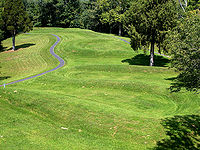
Mound building was a central feature of the public architecture of many Native American cultures from Chile to Minnesota. Thousands of mounds in the USA have been destroyed as a result of farming, pot-hunting, amateur and professional archaeology, road-building and construction. Surviving mounds are still found in river valleys, especially along the Mississippi, Tennessee and Ohio Rivers. Effigy mounds were used for burial, to support residential and religious structures, to represent a shared cosmology, and to unite and demarcate community. Common forms include conical mounds, ridge-top mounds, platform mounds, and animal effigy mounds, but there are many variations. Mound building in the USA is believed to date back to at least 1200 B.C.E. in the Southeast (see Poverty Point), and recent research shows that it may predate that as well. The Adena and Mississippian cultures are principally known for their mounds. The largest mound site north of Mexico is Cahokia, a vast World Heritage Site located just east of St. Louis, Missouri. The most visually impressive mound site (due to the area being free of trees) is in Moundville, Alabama. The largest conical burial mound can be found in Moundsville, West Virginia. Other sites in the U.S.A. include Indian Mounds Park, Wisconsin, Indian Mounds Park (Saint Paul, Minnesota), and Indian Mound Park, Alabama.
Through the mid-1800s, Native Americans were generally not believed to have built the mounds of the eastern U.S. A key work in the widespread recognition of the true origins of the mounds was the lengthy 1894 report of Cyrus Thomas of the Bureau of American Ethnology, which concluded that the prehistoric earthworks of the eastern United States were the work of Native Americans. Today, the term Mound Builder is a general term referring to the Native North American peoples who constructed various styles of earthen mounds for burial, residential, and ceremonial purposes. These included Archaic, and Woodland period, and Mississippian period Pre-Columbian cultures dating from roughly 3000 B.C.E. to the 1500s, and living in the Great Lakes region, the Ohio River region, and the Mississippi River region.
Middle East
Israel
Near the western city limits of modern Jerusalem in Israel, 19 tumuli have been documented (Amiran, 1958). Though first noticed in the 1870s by early surveyors, the first one to be formally documented was Tumulus #2 in 1923 by William Foxwell Albright, and the most recent one (Tumulus #4) was excavated by Gabriel Barkay in 1983. Since 21 kings reigned in Jerusalem during the Israelite monarchy from David to Zedekiah (who was conquered and humiliated by the Chaldean king, Nebuchadnezzar), it is not unreasonable to suspect that these mounds were the locations of ceremonies to mourn/honor them after they had already received proper burial in the royal tombs (probably located in the heart of the city where they could be continuously guarded). See 2 Chronicles 16:14, 21:19 (which states that King Jehoram was not given this honor), 32:33, the book of Jeremiah 34:5 (a conditional promise for Zedekiah that he did not earn), and Biblical archaeology. Gabriel Barkay popularized this theory after studying tumuli near Salamis in Cyprus.
Turkey
On the Anatolian peninsula, there are several sites where one can find the biggest specimens of these artificial mounds throughout the world. Three of these sites are especially important. Bin Tepeler (and other Lydian mounds of the Aegean inland), Phrygian mounds in Gordium (Central Anatolia) and the famous Commagene tumulus on the Mount Nemrut (Southeastern Anatolia).
Bin Tepeler is the most important of the enumerated sites with the number of specimens it has and with the dimensions of certain among them. It is in the Aegean inland of Turkey. The site is called "Bin Tepeler" (a thousand mounds in Turkish) and it is in the northwest of Salihli district of Manisa province. The site is very close to the southern shoreline of Lake Marmara (Lake Gyges or Gygaea). Bin Tepeler is a Lydian necropolis which dates back to 7th and 6th centuries B.C.E. These mounds are called "the pyramids of Anatolia" as there is even a giant specimen among them which attains 355 meters in diameter, 1115 meters in perimeter and 69 meters of height. According to the accounts drawn up by Herodotus, this giant tumulus belongs to the famous Lydian King Alyattes II who ruled between 619-560 B.C.E. There is also another mound belonging to King Gyges. The Gyges mound was excavated but the burial chamber hasn't been found yet. In this site, there are 75 tumuli dating back to Lydian period which belong to the nobility. A large number of smaller artificial mounds can also be observed in the site. There are other Lydian tumuli sites around Eşme district of Uşak province. Certain mounds in these sites had been plundered by raiders in the late 1960s and the Lydian treasures found in their burial chambers had been smuggled to United States which later had to cede them to Turkish authorities after a series of negotiations. These artifacts are now exhibited in the Archaeological Museum of Uşak.
Gordium is the capital of the Phrygian Kingdom. Its ruins are in the immediate vicinity of Polatlı district of the Turkish capital Ankara. In this site, there are approximately 80-90 tumuli which date back to Phrygian, Persian and Hellenistic periods. Only 35 tumuli were excavated so far. The mounds had been built between 8th century B.C.E. and 3rd or 2nd century B.C.E. The biggest tumulus in the site is believed to belong to the famous Phrygian King Midas. This mound had been excavated in 1957 and several bronze artifacts were collected from the wooden burial chamber. Among these artifacts, "omphalos bowls" and famous "Phrygian fibulae" (hooked needles which were used by the Phryigians to bond the clothes they wore) are especially important.
The Mount Nemrut is 86 km in the east of Adıyaman province of Turkey. It is very close to Kahta district of the same province. The mountain has, at its peak, 3050 meters of height above the sea level. A tumulus which dates back to the 1st century B.C.E. is situated at the peak of the mountain. This artificial mound has 150 meters of diameter and a height of 50 meters which was originally 55 meters. It belongs to the Commagene King Antiochus I Theos of Commagene who ruled between 69-40 B.C.E. The most interesting thing about the tumulus is that it is made of broken stone pieces which renders the excavation attempts almost impossible. The tumulus is surrounded by ceremonial terraces in the east, west and north. The east and west terraces have tremendous statues (reaching 8 to 10 meters of height) and bas reliefs of gods and goddesses from the Commagene pantheon where divine figures used to embody the Persian and Roman perceptions together.
Asia
Japan
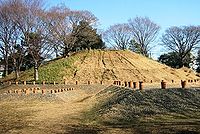
In Japan, powerful leaders built tumuli known as kofun. The Kofun period of Japanese history takes its name from these burial mounds. The largest is over 400 meters in length. In addition to other shapes, kofun include a keyhole shape.
Kofun (古墳) are megalithic tombs or tumuli in Japan, constructed between early 3rd century and early 7th century. They gave their name to the Kofun period (middle 3rd century - late 6th century). Most of the Kofun have the Keyhole-shaped mount (zenpo-koenfun (前方後円墳)), which was unique to the ancient Japan.
The kofun tumuli have taken various shapes through history. The most common one is a keyhole shape, having one square end and one circular end; there are also circular kofun (enpun (円墳)), rectangular ones (zempō-kōhō), and square ones (hōfun (方墳)). Orientation of kofun is not specified. For example, in the Saki Kofun group, all of circular parts are looking toward the north, but there is no such formation in the Yanagimoto kofun group. Haniwa, terra cotta figures were arrayed above and in the surroundings to delimit and protect the sacred area.
Kofun range in size from several meters to over 400m in length. The largest kofun is Daisen kofun, the tomb of the Emperor Nintoku, and the largest tomb by area in the world.
The funeral chamber was located beneath the round part and consisted of a group of megaliths. In 1972 unlooted Takamatsuzuka Tomb was found in Asuka and some details were revealed. Inside the tightly assembled rocks, whilte lime cement plasters were pasted and drawn colored pictures depicting the court or constellations. Stone coffin was placed in the chamber and accessories, swords and bronze mirrors were laid inside and outside of the coffin.
The oldest Japanese kofun is said to be Hokenoyama Kofun located in Sakurai, Nara, which dates to later 3rd century. In Makimuku district of Sakurai, earlier keyhole kofun (Hashihaka Kofun, Shibuya Mukaiyama Kofun) were built around early 4th century. The trend of keyhole kofun first spread from Yamato to Kawachi (where gigantic kofun as Daisen Kofun of Emperor Nintoku are built), and then throughout the country (except for the Tōhoku region) in 5th century. Later that century, keyhole kofun were also built in Gaya confederacy in Southern part of Korean peninsula.
Korea
The first burial mounds in Korea were dolmens which contained the material culture of the first millennium CE, such as bronze-ware, pottery, and other symbols of the elite of society.
The most famous tumulii in Korea, dating around 300 C.E., are those left behind by the Korean Baekje, Goguryeo, Silla, and Gaya states and are clustered around ancient capital cities in modern-day Pyongyang, Seoul, Jian, and Gwangju. The Goguryeo tombs, shaped like pyramids, are famous for the well-preserved wall murals like the ones at Anak Tomb No.3 which depict the culture and artistry of the people. The base of the tomb of King Gwanggaeto is 85 meters on each side, half of the size of the Great Pyramids.[2] Goguryeo Silla tombs are most noted for the fabulous offerings that have been excavated such as delicate golden crowns and glassware and beads that probably made their way to Korea via the Silk Road.
Korean tombs exhibit many styles borrowed by and from the Chinese, such as the styles of how the tombs were built and the use of the four guardian beasts, such as Ssu Ling. Additionally, many indigenous Korean artifacts and culture were transmitted, along with Chinese culture, to the tomb builders of early Japan, such as horsetrappings, bronze mirrors, paintings and iron-ware.
Ukraine, Russia and Central Asia
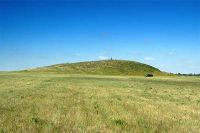
Kurgan (Russian: курга́н) is the Russian word (of Turkic origin[6]) for a tumulus, a type of burial mound or barrow, heaped over a burial chamber, often of wood.[7] The distribution of such tumuli in Eastern Europe corresponds closely to the area of the Pit Grave or Kurgan Culture in South-Eastern Europe.[8]
Kurgans were built in the Eneolithic, Bronze, Iron, Antiquity and Middle Age, with old traditions still smoldering in Southern Siberia and Central Asia. In time and space Kurgan Cultures are divided into a multitude of archeological cultures, most famous among them are Timber Grave, Pit Grave, Scythian, Sarmatian, Hunnish and Kuman-Kipchak cultures.
A plethora of placenames that include the word "kurgan" spread from Lake Baikal to the Black Sea.
Kurgan type barrows were characteristic of Bronze Age peoples, from the Altay Mountains to the Caucasus, Romania, and Bulgaria. Sometimes, burial mounds are quite complex structures with internal chambers. Within the burial chamber at the heart of the kurgan, members of the elite were buried with grave goods and sacrificial offerings, sometimes including horses and chariots. A circular burial mound constructed over a pit grave and often containing grave vessels, weapons, and the bodies of horses as well as a single human body; originally in use in the Russian Steppes but later spreading into eastern, central, and northern Europe in the third millennium B.C.E.
Frequently the monuments of these cultures are grouped territorially and coincide with the zone of Scythian-Saka-Siberian monuments. For Scythian-Saka-Sibirian monuments they are preceding cultures, have a number of the common features, and sometimes common genetic roots.[9] The Pazyryk, an ancient people who lived in the Altai Mountains lying in Siberian Russia on the Ukok Plateau, near the borders with China, Kazakhstan and Mongolia have also be associated with these spectacular burial mounds.[10] The archaeological site on the Ukok Plateau associated with the Pazyryk culture is included in the Golden Mountains of Altai UNESCO World Heritage Site.[11]
The most obvious archeological remains associated with the Scythians are the great burial mound (kurgans), some over 20m high, which dot the Ukrainian and Russian steppe belts and extend in many great chains for many kilometers along ridges and watershed. It is from them that most has been learnt about Scythian life and art.[12]
The tradition of kurgan burials touched not only the peoples who buried most of all of their deceased in kurgan structures, but also neighboring peoples who are known as not having a kurgan burial tradition among general population. Various Thracian kings and chieftains were buried in elaborate mound tombs found in modern Bulgaria, Phillip II, the father of Alexander of Macedon, was buried in a magnificient kurgan in present Greece, and legendary Midas, a king of ancient Phrygians, was buried in a kurgan near his ancient capital of Gordion[13]
Gallery
- PerepyatichaKurganGroup.gif
Engraving of Ukraine Perepyat kurgan cemetery group before its excavation
Notes
- ↑ (1971) "Oxford English Dictionary". Oxford Press, ISBN 019861117X
- ↑ (2000) Renfrew, Colin and Paul Bahn "Archaeology: Theories, Methods and Practice" (3rd Edition) Thames and Hudson. ISBN 0500281475
- ↑ (1996)Glenn Black Laboratory of Archaeology and The Trustees of Indiana University ["Burial Mounds"] Retrieved August 20, 2007
- ↑ (2007) Lendering, Jona. ["Alexander VI"] Retrieved August 20, 2007
- ↑ (2007) The Museum of Macedonia ["Royal Tombs—Vergina"] Retrieved August 20, 2007
- ↑ specifically of Tatar original according to the OED. TDK Dictionary : Kurgan [1]; The word kurgan ‘funerary mound’, is not only diffused in Russia, but throughout South-Eastern Europe (Ru. kurgán, ORu. kurganu, Ukr. kurhán, BRu. kurhan, Pol. kurhan, kurchan, kuran ‘mound’; Rumanian gurgan, dial. Hung. korhány), from Tatar, Tat., Osm., Kum. kurgan, Old Turkic kurgan "fortification," , Kirg. and Jagat. korgan, Karakirg. korgon, all from Turkotat. kurgamak "fortify," kurmak "erect".[citation needed]
- ↑ "kurgan." Webster's Third New International Dictionary, Unabridged. Merriam-Webster, 2002. http://unabridged.merriam-webster.com (14 Oct. 2006).
- ↑ Mario Alinei 'Interdisciplinary and linguistic evidence for Paleolithic continuity of Indo-European, Uralic and Altaic populations in Eurasia', 2003
- ↑ Akishev K.A., Kushaev G.A., 'Ancient culture of Sakas and Usuns in the valley of river Ili', Alma-Ata, Kazakh SSR Academy of Sciences publication, 1963 (pp 121 - 136)
- ↑ Ice Mummies: Siberian Ice Maiden. PBS - NOVA. Retrieved 2007-07-31.
- ↑ Golden Mountains of Altai. UNESCO. Retrieved 2007-07-31.
- ↑ John Boardman, I.E.S. Edwards, E. Sollberger, N.G.L. Hammond. The Cambridge Ancient History. Cambridge University Press. (Jan 16, 1992), p.550
- ↑ http://www.museum.upenn.edu/new/research/Exp_Rese_Disc/Mediterranean/Midas/intro.shtml
ReferencesISBN links support NWE through referral fees
- Albright, William F. (1923). Interesting finds in tumuli near Jerusalem. Bulletin of the American Schools of Oriental Research 10 (April): 1-3.
- Amiran, Ruth (1958). The tumuli west of Jerusalem, Survey and Excavations, 1953. Israel Exploration Journal 8 (4): 205-27.
- Barkay, Gabriel (2003). Mounds of mystery: where the kings of Judah were lamented. Biblical Archaeology Review 29 (3): 32-9, 66, 68.
- Grena, G.M. (2004). LMLK—A Mystery Belonging to the King vol. 1. Redondo Beach, California: 4000 Years of Writing History. ISBN 0-9748786-0-X.
- Grinsell, L.V., 1936, The Ancient Burial-mounds of England. London: Methuen.
- Nelson, Sarah Milledge (1993). The Archaeology of Korea. ISBN 0-521-40783-4.
- "Proto-Türkic rune-like inscription on silver cup (Issyk Inscription)" by A.S. Amanjolov, in "History Of Ancient Türkic Script," Almaty 2003
- "In Search of the Indo-Europeans: Language, Archaeology and Myth" by J. P. Mallory, ISBN 0-500-27616-1
- "The Kurgan Culture and the Indo-Europeanization of Europe: Selected Articles Form 1952 to 1993" von Marija Gimbutas u.a., ISBN 0-941694-56-9
- "Encyclopedia of Indo-European Culture" ed. James Mallory, D. Q. Adams, ISBN 1-884964-98-2
- D. Ya. Telegin et al., Srednestogovskaya i Novodanilovskaya Kul'tury Eneolita Azovo-Chernomorskogo Regiona. Kiev: Shlyakh, 2001. Reviewed by J.P. Mallory, JIES vol. 32, 3/4, p. 363–366.
- "Reconstruction Of The Genofond Peculiarities Of The Ancient Pazyryk Population (I-II Millennium B.C.E.) From Gorny Altai According To The mtDNA Structure" Voevoda M.I., Sitnikova V.V., Romashchenko A.G., Chikisheva T.A., Polosmak N.V., Molodin V.I http://www.bionet.nsc.ru/bgrs/thesis/99/.
- O.Ismagulov 'Population of Kazakhstan from Bronze Epoch to Present (Paleoanthropological research)', Science, Alma-Ata, 1970
- Thomas, Cyrus. Report on the mound explorations of the Bureau of Ethnology. Pp. 3-730. Twelfth annual report of the Bureau of Ethnology to the Secretary of the Smithsonian Institution, 1890-91, by J. W. Powell, Director. XLVIII+742 pp., 42 pls., 344 figs. 1894.
- Feder, Kenneth L.. ‘’Frauds, Myths, and Mysteries: Science and Pseudoscience in Archaeology’’. 5th ed. New York: McGraw Hill, 2006.
External links
- Lost Race Myth
- LostWorlds.org | An Interactive Museum of the American Indian
- LenaweeHistory.com | Mound Builders section, The Western Historical Society 1909, reprint.
- Artist Hideout, Art of the Ancients
- The Mound Builders, available for free via Project Gutenberg
- Kurgan Culture
- the Ipatovo kurgan
- excavated kurgans (archaeology.org).
- Ritual Sites, and Settlements: Eurasian Bronze and Iron Age book for download (www.csen.org)
- Definitions from Dictionary.com
Credits
New World Encyclopedia writers and editors rewrote and completed the Wikipedia article in accordance with New World Encyclopedia standards. This article abides by terms of the Creative Commons CC-by-sa 3.0 License (CC-by-sa), which may be used and disseminated with proper attribution. Credit is due under the terms of this license that can reference both the New World Encyclopedia contributors and the selfless volunteer contributors of the Wikimedia Foundation. To cite this article click here for a list of acceptable citing formats.The history of earlier contributions by wikipedians is accessible to researchers here:
The history of this article since it was imported to New World Encyclopedia:
Note: Some restrictions may apply to use of individual images which are separately licensed.
